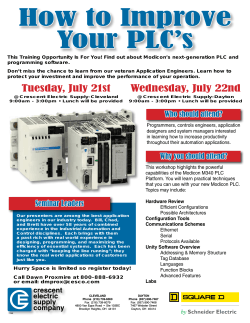
EUT 1040 Lecture 10: Programmable Logic Controllers
EUT 1040 Lecture 10: Programmable Logic Controllers PLC’s Are ... • Similar to a Microcontroller: – – – – Microprocessor Based Onboard Memory for Storing Programs Special Programming Language: Ladder Logic Input/Output Ports PLC’s Are... • Dissimilar to Microcontrollers: – Intended for Industrial Applications – I/O Designed to interface with Control Relays – Emphasis on Maximum Reliability PLC’s • Widely Applied in Every Industry • Were Developed to Simplify the Implementation of Control Automation Systems in Plants and Assembly Lines • Designed to Minimize the Number of Control Relays in a Process and Maximize the Ways Relays can be Used • First Applied to Automobile Industry in the Late 1960’s • Flexible, Reliable and Low Cost PLC Components I/O Modules • Input Modules: Input Signals can be AC or DC, Analog or Digital • Output Modules: Outputs are either AC or DC Analog Signals (Although it is possible to ‘Construct’ Digital Outputs) • Modern PLC’s have Expansion Ports to Increase the Number of Available Inputs and Outputs Examples of I/O Signals • Inputs: – – – – Pushbutton (Energizing or Grounding an Input) Relay Contact Output DC Voltage Level Digital Logic Signal (+5V or 0 V, etc) • Outputs: – – – – 24 V ac 120 V ac 120 Vdc etcetera PLC’s Use Ladder Logic • Ladder Logic Diagrams Provide a Method to Symbolically Show How Relay Control Schemes are Implemented • Relay Contacts and Coils, Inputs and Outputs lie on “Rungs” Between the Positive and Ground Rails Example of Ladder Diagram Relays • In General, Relays Transform a Control Signal into a Control Action • Relays Provide: – Isolation Between Input and Output – Leverage (Small Signal Can Control Large Action) – Automation (Minimize Human Interaction with a Control Process) Relay Components Basic Relay Symbols Relay Applications • Relays can be Designed to Perform Many Functions – Detect Out of Limit Conditions on Voltages and Currents – Start Motors – Prevent Motors from Over Heating – Control Assembly Lines – Adjust Lighting PLC Timers and Motor Protection Industrial Communications • RS-422 (EIA 422): Asynchronous Serial Communications , similar in many respects to RS-232 • Faster (up to 100 Kbps) than RS-232 • Better Noise Immunity – Differential (Balanced signal) Protocol – Makes use of Twisted Pair lines - 1 pair for transmit, one pair for receive (4 Lines vs. 3) EIA-422 Basics • Can be 1 Master Transmitter feeding up to 10 Slave Receivers • Can be Peer-to-Peer, like RS-232 • Data is sent and received via Differential Ports - Common Mode Rejection (Noise common to both inputs is attenuated) • Twisted Pair also reduces EMI at low cost Common Mode Rejection EIA 485 (RS-485) • More Modern, Faster and Flexible (supports TCP/IP) • Since it uses a differential balanced line over twisted pair (like EIA-422), it can span relatively large distances (up to 4000 feet or just over 1200 metres). • In contrast to EIA-422, which has a single driver circuit which cannot be switched off, EIA-485 drives need to be put in transmit mode explicitly by asserting a signal to the driver. This allows EIA-485 to implement linear topologies using only two lines. IEEE 802.3 (Ethernet) • Star Topology (Hub and spokes) • Standard for computer networks since the 1990’s • Becoming more and more popular in Industrial settings • Uses twisted pair data cables terminated in 8P8C (sometimes incorrectly called RJ45) modular plugs, wired according to TIA/EIA568-B Twisted Pair Cables • Twisting a pair of wires that act as a communication channel will: – Minimize the loop area between the pair (minimize the self-inductance and capacitance) – Which in turn tends to cancel out much of the electromagnetic interference from external sources and crosstalk from adjacent pairs – Improve the efficiency of the channel PLC Special Features • • • • • Time Delay Relays Counter Relays Special Functions User Defined Functions Special Bits Time Delay Relays • When TD Relay Pick-Up Coil is Energized, a Delay is Initiated • Normally Open Contacts Wait to Close until Delay is Completed • Normally Closed Contacts Wait to Open until Delay is Completed • Very Useful for Creating a Sequence of Control Events Time Delay Symbol • Can be Constructed With or Without a Reset Input Making Use of Delays • Delay Motor Start While Alarm Sounds for Safety Counters • Counter Relays must “Count” a predetermined number of events before changing contact status • Can Count Up (UpCounter) or Count Down (DownCounter) • e.g. An UpCounter is set to 8 and is programmed to detect every occurrence of a 5 Volt pulse. When it has detected 8 such occurrences, the NO Contacts close and the NC contacts open. • Great for making Real-Time Clocks, etc Special Functions • Modern PLCs can perform many Math and Logic Functions without additional Ladder Logic Programming – – – – Differentiation, Integration +, -, *, / Boolean Logic Functions (AND, NOT, OR) Master Control Functions (Reset, etc) Motor Protection • Essential Part of Motor Control • Protect against: – – – – – – Under Voltage Under Frequency (AC Machines Only) Over Current Over Heating Over Speed Over Load Motor Protection Schemes • Incorporated Directly in Ladder Logic Control Schemes References • Skvarenina/DeWitt, Electrical Power and Controls, Pearson-Prentice Hall, 2004
© Copyright 2025





















